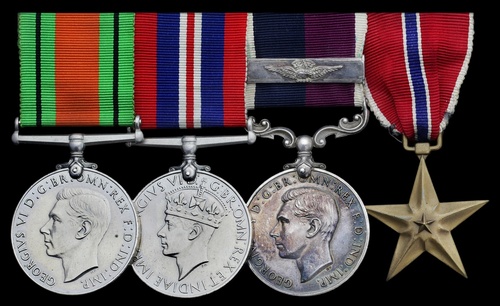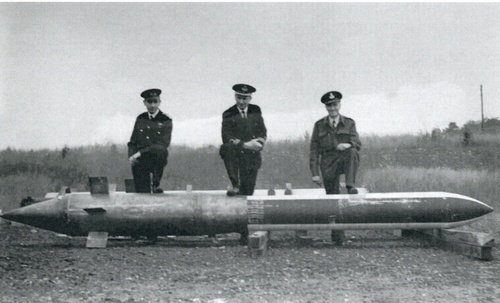Auction: 20001 - Orders, Decorations and Medals - conducted behind closed doors
Lot: 746
A highly unusual and interesting American Bronze Star group of four awarded to Warrant Officer, formerly Flight Lieutenant F. C. Cowdrey, Royal Air Force, who served as Armament Liaison Officer to the Technical Operations Section, Headquarters, U.S. Eighth Air Force, from 1 March 1944 to 1 May 1945, and was instrumental in the deployment of the 'Disney bomb'
Defence and War Medals 1939-45; Royal Air Force L.S. & G.C., G.VI.R. with Second Award Bar (W/O. F. C. Cowdrey. (366058). R.A.F.); United States of America, Bronze Star, unnamed as issued, mounted as worn, the last in original case of issue with pin badge, good very fine (4)
American Bronze Star London Gazette 16 April 1946. The original recommendation states:
'For meritorious service in connection with military operations while serving as Armament Liaison Officer to the Technical Operations Section, Headquarters, Eight Air Force from 1 March 1944 to 1 May 1945. Flight Lieutenant Cowdrey achieved excellent results on the many and varied problems assigned to him. He took complete charge of the assembly, fusing and loading of the 4250 pound rocket-boosted, concrete piercing bomb designed by the Royal Navy and was instrumental in developing a satisfactory sway brace system for this device.'
175 Bronze Stars awarded to the Royal Air Force during the Second World War.
Frederick Charles Cowdrey was born on 4 October 1909 and spent his childhood living at 21 Harley Street, Fratton Portsmouth. Educated at the Junior Technical School, Portsmouth, he enlisted into the Royal Air Force on 22 September 1925 as a Halton Apprentice and initially served with No. 2 Wing as an Armourer, before being commissioned Flying Officer on Probation, Technical Branch, on 13 May 1943. It was here that Cowdrey was conferred with the Bronze Star by the President of the United States of America for his work involving the 'Disney' bomb, also known as the 'Disney Swish' (Combat Bulletin No. 57: Activities in ETO Disney Swish, refers). Its name was inspired by the 1943 propaganda film, Victory Through Air Power, produced by the Walt Disney Studios, that provided the inspiration for the design ("The Disney Bomb Project", 92nd Bomb Group: Fame's Favoured Few, refers).
This weapon was a 16ft 6in. long rocket-assisted bunker buster bomb designed to penetrate hardened concrete targets, such as the submarine pens at St. Nazaire, which could largely resist conventional free-fall bombs. Devised by the British Liberal politician, magistrate and inventor, Captain Edward Terrell, O.B.E., R.N., its cordite fuelled rockets could achieve an impact speed of 990mph (1,590 km/hr), substantially beyond the 750mph free-fall impact velocity of the 5 ton Tallboy 'earthquake' bomb for comparable purposes (One Day in a Very Long War, by Jonathan Cape, refers). Having shown the Admiralty a 'mock up' under the wing of a Boeing B-17 Flying Fortress, Terrell finally got the go-ahead for the full development of his bomb at a meeting of the British War Cabinet in May 1944, it being designated "P Plus" priority.
Despite being a British design, 'Disneys' were only used by the U.S.A.A.F., indeed they were never used by R.A.F. Bomber Command. Deployed by the 92nd Bombardment Group, they were carried from the same external mounting used for the Aeronca GB-1 glide bomb (B-17 Flying Fortress Story, refers), but appear to have been adapted by Cowdrey to cope with the weight and requirement for precision.
Deployment of the 'Disney'
The first 'Disney' attack was against the port of Ijmuiden, Netherlands, which was the site of two separate fortified pens used by the German Navy to house their Schnellboote - fast torpedo boats, more commonly known to the Allies as E-Boats, which at that time were considerable threat to the supply lines serving Allied forces in western Europe. Protected by a 10-foot thick concrete roof, the bunkers were successfully attacked by 9 aircraft of the 92nd Bomb Group, U.S.A.A.F., on 10 February 1945. Deploying 18 Disney bombs from 20,000 feet, the concrete was pierced and the pens destroyed. A similar attack was mounted on the Valentin submarine pens at Farge, near Bremen in Germany. All but destroyed by two 10-ton Grand Slam bombs dropped by the R.A.F. three days early on 27 March 1945, the launching of more than 60 'Disneys' convinced the Germans to finally abandon the complex, which was captured by Allied forces 4 weeks later (Barnes Wallis' Bombs: Tallboy, Dambuster & Grand Slam, refers).
Cowdrey was presented with the Bronze Star on 18 March 1946 at the American Embassy in London. Having relinquished his commission on 14 August 1946, he was awarded a clasp to the L.S. & G.C. Medal as a Warrant Officer on 6 August 1962 and retired a couple of years later. He died in October 1999 in North Dorset; sold with copied research.
For further details, please see the short film titled 'The Disney Swish':
https://www.youtube.com/watch?v=a5FGu31ymJM
Subject to 20% VAT on Buyer’s Premium. For more information please view Terms and Conditions for Buyers.
Sold for
£1,000
Starting price
£320







